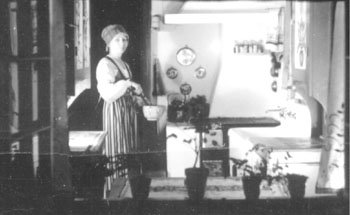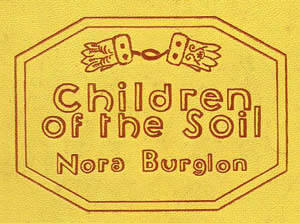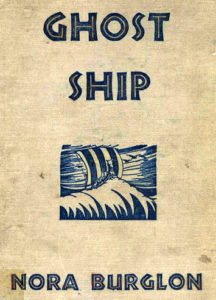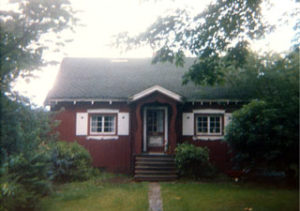 In Everett , from the 1930s to 1976, lived a woman who made her mark upon society, her physical environment, and the minds of countless children whom she taught and who read her books. She was Nora Burglon, author, artist, teacher, world traveler, and Scandinavian folklorist. Born April 28, 1900 in Minnesota, she came from, as she was proud to say, “sturdy Swedish stock,” She researched and shared that heritage for much of her life. For someone who was so well known nationally and internationally, little was known about her private life. In 1935 she was listed in Polk’s City Directory, as a writer and as managing director for “Scandinavian Crafts”, a small business in Everett. Also in the 1930s she began to fulfill a life-long dream to build a little cottage in the Swedish peasant style on Rucker Hill.
In Everett , from the 1930s to 1976, lived a woman who made her mark upon society, her physical environment, and the minds of countless children whom she taught and who read her books. She was Nora Burglon, author, artist, teacher, world traveler, and Scandinavian folklorist. Born April 28, 1900 in Minnesota, she came from, as she was proud to say, “sturdy Swedish stock,” She researched and shared that heritage for much of her life. For someone who was so well known nationally and internationally, little was known about her private life. In 1935 she was listed in Polk’s City Directory, as a writer and as managing director for “Scandinavian Crafts”, a small business in Everett. Also in the 1930s she began to fulfill a life-long dream to build a little cottage in the Swedish peasant style on Rucker Hill.
Burglon became known in the ’30s and ’40s as a prolific author. Six books of fiction for children were written from 1931 to 1939, another four between 1940 and 1947. Add to that a large number of magazine articles. Her stories were carefully researched, for accurate detail and a sense of place, through her many travels-to Europe and Scandinavia, the Carribean and Hawaii, even to the Arctic.
 One book, Children of the Soil, A Story of Scandinavia ,1933 (serialized 1931-32) was named an Honor Book by the Newbery Foundation. That award placed Burglon alongside Laura Ingalls Wilder and Isaac Bashevis Singer in the pantheon of writers who won similar Newbery awards. The story follows the adventures of two children and their widowed mother as they struggle to rise from the status of poor crofters to respectable farmers. It is filled (as are all her books) with adventure, moral lessons, cultural and environmental education, and (usually) a young girl as heroine, who has the commonsense, will, and faith enough to turn every ill to the good.
One book, Children of the Soil, A Story of Scandinavia ,1933 (serialized 1931-32) was named an Honor Book by the Newbery Foundation. That award placed Burglon alongside Laura Ingalls Wilder and Isaac Bashevis Singer in the pantheon of writers who won similar Newbery awards. The story follows the adventures of two children and their widowed mother as they struggle to rise from the status of poor crofters to respectable farmers. It is filled (as are all her books) with adventure, moral lessons, cultural and environmental education, and (usually) a young girl as heroine, who has the commonsense, will, and faith enough to turn every ill to the good.
Burglon’s observations on fairness and justice ran through all her work and society fell short of her ideals much of the time. In Children of the Soil she spoke of feeding weeds to goats: “That was one fine thing about goats. It was as if they were related to the crofter folk, for they did not believe in wasting anything they could make good use of. Now cows, on the other hand — well, cows were more finicky – they were more like the gentry: nothing was ever just exactly enough, nor ever just exactly good enough, either.” At a point in the story when the heroine’s little brother is falsely accused, Burglon wrote, “Nicolina wanted to fly at the big red-faced woman – she who always made the girl feel as if being a crofter were something akin to being a thief or a beggar.” She had no patience with people who act as sheep and sweep along with the crowd: “People never knew half the time what they themselves really wanted to say. Somebody said, ‘Cry-lunta [crybaby].’ Then all the rest said the same. Somebody else said, ‘Bravo!’ Then they all said that.”
One of Burglon’s traits was a talent for description that painted in words a picture so clear that she might as well have applied it to canvas. On the appearance of children dressed in many layers against the cold: “A red nose and a pair of bright eyes shone out through each bundle. There was a pair of heavy overshoes under each bundle which kept it moving along, and a pair of red mittens which helped it get up when the bundle fell down.”
 [Book cover on left is for Ghost Ship : a Story of Norway Published in 1936.]
[Book cover on left is for Ghost Ship : a Story of Norway Published in 1936.]
In 1941, Burglon was in Honolulu when Pearl Harbor was bombed. After watching the catastrophe from her hotel window she spent days helping the injured. During World War II she organized dispatch of thousands of relief packages to Scandinavia. She spent time in Hawaii as a teacher and had, as a mentor, Mrs. Moriama, “whose deep and kindly understanding of children supplied the model for Mrs. Urago” in the book, Shark Hole, A Story of Modern Hawaii, published in 1943. In the story Nani, the young girl, observes, “Mrs. Urago understood that some people were untamed spirits. Their work was to give light and understanding to others, not to store knowledge within themselves.”
Burglon didn’t shy away from the war, but tried to help children understand their feelings and those of others in that time of turmoil. In one part of the book she spoke of the legend of the Black Shark which terrorized the Hawaiian people. Years before, it had promised to stop if the people brought offerings to the sea once a year on the seventh day of the last month in the year. In the story, it was believed to have returned. ” Nani’s face lighted with sudden understanding, ‘….. That’s the seventh of December. Pearl Harbor was bombed on that day and the people forgot.’ Her eyes widened with fear.”
Another observation on the war deals with black-outs and the emotional toll they took: “[Before Pearl Harbor] the hamlet had bloomed with the lights of a thousand windows. Now there was no light except the glimmering of the moonbeams upon the cane sheds. It was this darkness, more than anything else, that reminded the three children that their country was at war.” For balance against the gloom, Burglon wrote, “War had changed many things in the Islands, but the sound of the cane rushing down through the flumes over the valleys, had not changed at all. Neither had the sweet smell of cane juice, which rose like a warm breath.”
Another point she had to make regarded the discrimination against Japanese-American citizens that was prevalent in that time. In the story, a teacher speaks to a student who injured a Japanese-American child, “‘My grandfather came here from China as a coolie laborer,’ Miss Chun went on. ‘Yoshio’s grandfather came from Japan as a poor farmer. Your grandfather came from Puerto Rico as a contract laborer to work in the sugar cane. It is the people who have come from all these various lands that have made Hawaii the wonderful place it is. Not one of these people could have done it alone. All of us, not any one people, are called Americans.'”
Burglon was also an environmentalist before the word was even coined. Her writing is full of vivid descriptions of nature, guided by her artist’s eye. She appreciated all aspects of the natural world and decried mankind’s ignorance in upsetting the order. In Shark Hole she speaks of the damage caused by imported species and plants: “Because the original Hawaiian birds had become nearly extinct, bird lovers had brought in others. The imported birds, lacking the food to which they were accustomed, became fruit eaters and the Hawaiian orchardists paid dearly for their birdsong.” Crawfish had been brought in to eat mosquitoes, but fell on the taro roots instead. Lantana had once been grown in gardens. Now it made miles of highland country all but impassable.” Although Burglon’s head-on approach to the world’s problems was accepted without a blink by her many young readers, it was not necessarily so with their parents or teachers. I was told by one former student of 1944, that when she suggested that Burglon be read aloud, the idea was put down because of the impression that Burglon had “communistic leanings.” Her deep faith in Christianity might have surprised her detractors. For instance, how many kitchens do you know that have the entire Lord’s Prayer written in Swedish (or any other language, for that matter) surrounding the room in a border? Or “Blessed are they that do” and “Work is Love made visible” written in decorative script on a cupboard door or ceiling beam? Burglon’s little cottage had these and more.
In Better Homes and Gardens magazine (Sept.1940), Burglon described her motivation for building her home, “I suppose it was those hearty, stubborn Swedish pioneers, my grandparents, who bequeathed to me my life-long hunger for simple walls of white, for bright rafters and flowering beams, for vibrant homespuns, gleaming copper-studded chests, and sunny braided rugs.” And build it, she did, throughout the 1930s, and often at odds with the advice of her carpenters. Her books were typed out from a desk by the window of the small loft bedroom, designed as “the maiden’s bower” where unmarried daughters slept. She described this room as containing “great quantities of manuscripts in various stages of construction or decomposition.
“Mine is a joyous little home of singing colors and great peace. In my many authoring trips to the north countries, I had gathered the weavings and chests, the buckets and kettles, the color harmonies and folk designs that would make it truly Scandinavian, completely my own. I built a harmony of vermilion and royal blue, hues as strong and hearty as the Swedish peoples themselves. The motifs on doors, rafters, and beams I drew from the peasant art of these people, …..” “The limb [of the tree of life] was their first symbol, the wheel of the sun-worshiper, the second, the “sacred heart of Jesus” their third. The heart has become a heart-shaped leaf, the base of a flower, or the center of the design from which stalks and buds appear to grow.” Burglon lived, surrounded by the beauty she created, for the rest of her life in the little cottage in Everett.
 Nora Burglon died in 1976 at the age of 75. Her books were out of print, most of the print forms having been melted for scrap during the war. A short obituary stated that she was a retired teacher with the Everett School District and left numerous cousins across the country and a niece and nephew in Sweden. But, what of her life before and after that prolific and public period of the ’30s and ’40s? The Women’s Legacy Project members are writing a book about Snohomish County women. Burglon deserves a prominent chapter. If you have any information about her, please contact us (see menu above). I want to fill in the gaps and do justice to the story of a remarkable woman.
Nora Burglon died in 1976 at the age of 75. Her books were out of print, most of the print forms having been melted for scrap during the war. A short obituary stated that she was a retired teacher with the Everett School District and left numerous cousins across the country and a niece and nephew in Sweden. But, what of her life before and after that prolific and public period of the ’30s and ’40s? The Women’s Legacy Project members are writing a book about Snohomish County women. Burglon deserves a prominent chapter. If you have any information about her, please contact us (see menu above). I want to fill in the gaps and do justice to the story of a remarkable woman.
© 2003 – 2006 Louise Lindgren, All Rights Reserved
